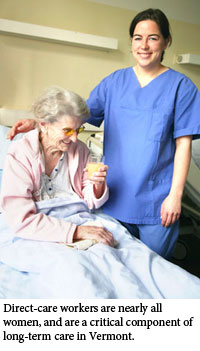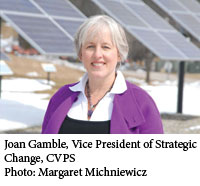Mary Powell Lights Up Vermont
Green Mountain Power supplies energy to more than 200,000 Vermonters (nearly a third of the population), and employs 200 people. The energy it transmits is comprised largely of nuclear power from Vermont Yankee in Vernon and hydropower from Hydro Quebec. As contracts with these companies expire, GMP is branching into cost-effective, renewable energy sources – such as the proposed Kingdom Community Wind project in Lowell, which awaits a go-ahead response from the Public Service Board in early May.
At the head of this cutting-edge company is Mary Powell, one of only five female CEOs of investor-owned industrial utilities in the country. Yet Powell, 50, calls herself an “accidental executive”: Far from being groomed from day one for an executive future, she acquired a wide-ranging resume that seems couldn’t have better prepared her for the work she does today. So how did she do it?
A New York City native, Powell attended the Fiorello LaGuardia High School of Music and Art (and now Performing Arts) thinking she would follow in her actor father’s footsteps. “My upbringing was about arts and music, not business,” Powell recalls. At the same time, however, she felt a drive to “take care of myself and others,” and worked pragmatically at saving money.
“Although my Dad was successful later on, perhaps because of an insecurity growing up around money, I was very industrious, worked at any job I could, and saved a lot of my money,” she says. For a long time, however, Powell didn’t see herself as a business person. “I grew up feeling sorry for people in business; I thought big corporations were stuffy.”
Read the full article |
|
| |
|
Making the Economy our Own – The Growing Care Crisis
When I started this series, I first spoke with Stephanie Seguino, an internationally recognized economist at the University of Vermont. “Why should women care about economics?” I asked her.
“Because there’s a growing care crisis coming,” she answered, commenting on how seldom “care” makes U.S. headlines – but needs to. “We like to think of ourselves as independent and self-sustaining. But every single human being has to live as a dependent. Every child is dependent the first 18 years of life. Many human beings will live with a chronic illness that takes care. Most human beings will get old and need care as they age. Being dependent is simply part of life.”
Seguino notes that many other advanced economies provide for inevitable needs as public policy. When she worked in Trinidad/Tobago, which most Americans consider an impoverished country, the young mothers there were shocked to learn that American moms do not get what they considered normal: paid maternity leave to stay home with newborn infants.
According to the Australia-based Women’s Network of The Association of Professional Engineers, Scientists, and Managers, which compiles worldwide information on maternity leave, only six countries out of 140 provide no financial support for new mothers. The U.S. is in the company of Lesotho, Swaziland, Papua New Guinea, New Zealand, and Australia – but Australia grants one year’s leave with a guarantee of returning to a job, compared to only 12 weeks in the U.S. By comparison Trinidad/Tobago provides 12 weeks maternity leave, but at 100 percent of pay.
Wealthier countries do even better. Canada provides 55 percent of wages for 15 weeks. Most European countries, utilizing financial instruments similar to unemployment insurance, grant between 85 and 100 percent of pay, sometimes for both parents, for as long as 64 weeks. Most invest in healthcare systems, too, using a variety of financial tools to accomplish universal care. They invest in a healthy beginning for all children, regardless of income, and less stressful health care for adults.
Read the full article |
 |
| |
|
Many Beats to Get Vermonters on Their Feet in April –
Get Set to Dance with Angélique Kidjo, the Premier Diva of Africa!
On United Nations Day of 2009, at an event dedicated specifically to U.N. Peacekeepers, members of the General Assembly were urged out of their seats by the charismatic performer Angélique Kidjo. Initially, perhaps each delegate was debating the propriety of such an action – but soon the body was on its feet as one, many clapping to the rhythmic beat filling the hall, some high-fiving or embracing Kidjo as she wended her way through the aisles, all the while ebulliently belting out the song “Afirika,” enjoining them to sing, too.
Read the full article |
 |
| |
|
Vermont’s Energy Choices –
The Power to Change
Worried speculation began around the world almost as soon as the Japanese, already shocked by the damage caused by the 9.0-magnitude earthquake and tsunami that struck on March 11, 2011, learned of explosions at the Fukishama Dai-ichi nuclear plant near the quake’s epicenter on Japan’s northeast coast. Would this become one of the three worst nuclear disasters in history, after Three Mile Island in 1979 and Chernobyl in 1986?
Japanese and plant officials were accused of not getting enough information to the public in a timely manner to protect them from radiation. Now, reports worsen daily: radiation is turning up in food gardens, Tokyo residents are warned not to drink possibly radioactive tap water, and nuclear plant workers are being hospitalized for radiation exposure. Japan’s residents are just beginning to pay the ultimate price for nuclear energy gone wrong.
Yet, three days after the disaster, Louisiana-based Entergy LLC, which owns the Vermont Yankee nuclear plant, was focused on spin. Located on the Connecticut River in the southern Vermont town of Vernon, VY, Entergy claimed, was “built to withstand the effects of natural disasters, including earthquakes and catastrophic flooding.” Critics disagreed, noting the aging facility’s recent series of tritium leaks, outmoded design, and dated infrastructure that, some say, make Vermont Yankee a “not if but when” disaster.
Read the full article |
 |
| |
|
An Energetic Woman: Joan Gamble
Joan Gamble loves her job. For the last 30 years, she has carved a lucrative, win-win career out of helping customers manage their electricity use more efficiently, lowering not only their own electric bills but also helping the utility’s bottom line and benefitting the environment in the process.
Now, as Vice President for Strategic Change and Business Services of the Central Vermont Public Service Corporation (CVPS), Vermont’s largest electric company, Gamble is focusing on the next major shift in electric utility management: bringing the newest generation of communication technology to utility customers so they can be better informed, and make better choices, about their energy use.
Growing up in Delaware in the environmentally conscious 1970s, Gamble became intrigued by the notion of energy conservation as a means of avoiding building additional power plants. She graduated in 1980 from Wesleyan, “a little liberal arts college in Connecticut where you can design your own major,” having created a degree program in environmental studies and energy issues. She moved to the Pacific Northwest, where her brother lived, drawn by the fact that Oregon and Washington State were at that time hotbeds of progressive energy and environmental programs. She hooked up with a job at a consulting firm engaged in integrative resource management. After just a few years, she left private consulting to work for a utility.
Read the full article |
 |
|